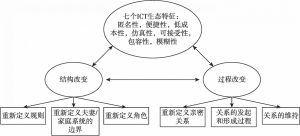摘要
当前,信息与通信技术已经充分渗透家庭日常互动,影响家庭关系。已有实证研究考察了信息与通信技术对不同类型家庭关系的影响,得出了复杂的结论。研究者基于人际关系的增强和侵占观点、驯化理论、科技与家庭关系的多重理论模型对相关结论进行了解释。心理学在运用信息与通信技术实施家庭干预以及直接参与信息与通信技术产品设计方面有了实践性突破。未来可以围绕整体家庭功能视角、信息与通信技术影响家庭的心理机制、我国家庭文化特征以及应用实践等方面做更多研究。
作者
徐华春 ,四川师范大学副教授,E-mail: seanxu1981@163.com。
张文婷 ,南京大学社会学院。
钟霜 ,四川师范大学心理学院。
胡琰敏 ,四川师范大学心理学院。
- 安利利,王兆鑫.(2020).孝道与平权:数字鸿沟中的文化反哺与再哺育——大学生与父母在微信平台上的亲子关系研究.中国青年社会科学,39(4),111-117. doi:10.16034/j.cnki.10-1318/c.2020.04.017
- 方晓义,徐洁,孙莉,张锦涛.(2004).家庭功能:理论、影响因素及其与青少年社会适应的关系.心理科学进展,12(4),544-553.
- 牛璐,雷雳,谢笑春.(2016).社交网站在浪漫关系进程中的作用.心理科学进展,24(12),1926-1933.
- 宋静静,谷传华,张永欣,张菲菲,郝恩河.(2013).留守青少年互联网使用对社会创造性的影响:社会关系网络的中介作用.中国特殊教育,(1),63-69.
- 苏斌原,张卫,苏勤,喻承甫.(2016).父母网络监管对青少年网络游戏成瘾为何事与愿违?——一个有调节的中介效应模型.心理发展与教育,32(5),604-613. doi:10.16187/j.cnki.issn1001-4918.2016.05.11
- 唐灿.(2010).家庭现代化理论及其发展的回顾与评述.社会学研究,25(3),199-222. doi:10.19934/j.cnki.shxyj.2010.03.009
- 吴波,黄希庭.(2012).因满足而幸福:婚姻期待研究回顾与展望.心理科学进展,20(7),1098-1109.
- Anderson,D.R.,& Hanson,K.G.(2017). Screen media and parent-child interactions. In Media exposure during infancy and early childhood(pp.173-194). Springer,Cham. doi:10.1007/978-3-319-45102-2_11
- Bacigalupe,G.,& Lambe,S.(2011). Virtualizing intimacy:Information communication technologies and transnational families in therapy. Family Process,50(1),12-26. doi:10.1111/j.1545-5300.2010.01343.x
- Bechara,A.,Bertolino,M.V.,Casab,A.,Munarriz,R.,Goldstein,I.,Morin,A.,& Fredotovich,N.(2003). Romantic partners use of pornography:Its significance for women. Journal of Sex and Marital Therapy,29(1),1-14.
- Blinn-Pike,L.(2009). Technology and the family:An overview from the 1980s to the present. Marriage and Family Review,45(6-8),567-575 doi:10.1080/01494920903224459
- Bridges,A.J.,& Morokoff,P.J.(2011). Sexual media use and relational satisfaction in heterosexual couples. Personal Relationships,18(4),562-585.
- Calvo,R.A.,Vella-Brodrick,D.,Desmet,P.,& Ryan,R.M.(2016). Editorial for “positive computing:A new partnership between psychology,social sciences and technologists”. Psychology of Well-Being,6(1),10. doi:10.1186/s13612-016-0047-1
- Carvalho,J.,Francisco,R.,& Relvas,A.P.(2015). Family functioning and information and communication technologies:How do they relate?A literature review. Computers in Human Behavior,45,99-108. doi:10.1016/j.chb.2014.11.037
- Coyne,S.M.,Stockdale,L.,Busby,D.,Iverson,B.,& Grant,D.M.(2011). “i luv u:)!”:A descriptive study of the media use of individuals in romantic relationships. Family Relations,60(2),150-162. doi:10.1111/j.1741-3729.2010.00639.x
- Dworkin,J.,McCann,E.,& McGuire,J.K.(2016). Coparenting in the digital era:Exploring divorced parents’ use of technology. Contemporary Perspectives in Family Research,10,279-298.
- Erickson,J.J.,Martinengo,G.,& Hill,E.J.(2010). Putting work and family experiences in context:Differences by family life stage. Human Relations,63(7),955-979. doi:10.1177/0018726709353138
- Ferguson,C.J.,San Miguel,C.,Garza,A.,& Jerabeck,J.M.(2012). A longitudinal test of video game violence influences on dating and aggression:A 3-year longitudinal study of adolescents. Journal of Psychiatric Research,46,141-146. doi:10.1016/j.jpsychires.2011.10.014
- Francisco,V.(2015). ‘The internet is magic’:Technology,intimacy and transnational families. Critical Sociology,41(1),173-190. doi:10.1177/0896920513484602
- Friemel,T.N.(2016). The digital divide has grown old:Determinants of a digital divide among seniors. New Media and Society,18(2),313-331. doi:10.1177/1461444814538648
- Ganong,L.H.,Coleman,M.,Feistman,R.,Jamison,T.,& Markham,M.S.(2012). Communication technology and postdivorce coparenting. Family Relations,61(3),397-409. doi:10.1111/j.1741-3729.2012.00706.x
- Hassenzahl,M.,Heidecker,S.,Eckoldt,K.,Diefenbach,S.,& Hillmann,U.(2012). All you need is love:Current strategies of mediating intimate relationships through technology. ACM Transactions on Computer-Human Interaction,19(4),30.
- Haythornthwaite,C.(2005). Social networks and internet connectivity effects. Information,Community and Society,8(2),125-147. doi:10.1080/13691180500146185
- Hertlein,K.M.(2012). Digital dwelling:Technology in couple and family relationships. Family Relations,61(3),374-387. doi:10.1111/j.1741-3729.2012.00702.x
- Huisman,S.,Edwards,A.,& Catapano,S.(2012). The impact of technology on families. International Journal of Education and Psychology in the Community,2(1),44-62.
- Konrath,S.(2013). The empathy paradox:Increasing disconnection in the age of increasing connection. In Handbook of research on technoself:Identity in a technological society(pp.204-228). IGI Global.
- Kraut,R.,Patterson,M.,Lundmark,V.,Kiesler,S.,Mukophadhyay,T.,& Scherlis,W.(1998). Internet paradox:A social technology that reduces social involvement and psychological well-being?. American Psychologist,53(9),1017-1031. doi:10.1037//0003-066x.53.9.1017
- Ledbetter,A.M.,& Kuznekoff,J.H.(2012). More than a game:Friendship relational maintenance and attitudes toward Xbox LIVE communication. Communication Research,39(2),269-290. doi:10.1177/0093650210397042
- MacDonell,K.W.,& Prinz,R.J.(2017). A review of technology-based youth and family-focused interventions. Clinical Child and Family Psychology Review,20(2),185-200. doi:10.1007/s10567-016-0218-x
- McDaniel,B.T.,Galovan,A.M.,Cravens,J.D.,& Drouin,M.(2018). “Technoference” and implications for mothers’ and fathers’ couple and coparenting relationship quality. Computers in Human Behavior,80,303-313. doi:10.1016/j.chb.2017.11.019
- McKenna,K.Y.,Green,A.S.,& Gleason,M.E.(2002). Relationship formation on the internet:What’s the big attraction?. Journal of Social Issues,58(1),9-31. doi:10.1111/1540-4560.00246
- Mesch,G.S.(2010). The family and the internet:The Israeli case. Social Science Quarterly,84(4),1038-1050. doi:10.1046/j.0038-4941.2003.08404016.x
- Morey,J.N.,Gentzler,A.L.,Creasy,B.,Oberhauser,A.M.,& Westerman,D.(2013). Young adults’ use of communication technology within their romantic relationships and associations with attachment style. Computers in Human Behavior,29,1771-1778. doi:10.1016/j.chb.2013.02.019
- Mullen,C.,& Hamilton,N.F.(2016). Adolescents’ response to parental Facebook friend requests:The comparative influence of privacy management,parent-child relational quality,attitude and peer influence. Computers in Human Behavior,60,165-172. doi:10.1016/j.chb.2016.02.026
- Nedelcu,M.,& Wyss,M.(2016). ‘Doing family’ through ICT-mediated ordinary co-presence:Transnational communication practices of Romanian migrants in Switzerland. Global Networks,16(2),202-218. doi:10.1111/glob.12110
- Przybylski,A.K.,Kou,M.,Dehaan,C.R.,& Gladwell,V.(2013). Motivational,emotional,and behavioral correlates of fear of missing out. Computers in Human Behavior,29,1841-1848. doi:10.1016/j.chb.2013.02.014
- Przybylski,A.K.,& Weinstein,N.(2013). Can you connect with me now?How the presence of mobile communication technology influences face-to-face conversation quality. Journal of Social and Personal Relationships,30(3),237-246. doi:10.1177/0265407512453827
- Radesky,J.S.,& Christakis,D.A.(2016). Increased screen time:Implications for early childhood development and behavior. Pediatric Clinics of North America,63(5),827-839. doi:10.1016/j.pcl.2016.06.006
- Schneider,J.P.,Weiss,R.,& Samenow,C.(2012). Is it really cheating?Understanding the emotional reactions and clinical treatment of spouses and partners affected by cybersex infidelity. Sexual Addiction and Compulsivity,19(1-2),123-139. doi:10.1080/10720162.2012.658344
- Tanis,M.,Louw,M.V.D.,& Buijzen,M.(2017). From empty nest to social networking site:What happens in cyberspace when children are launched from the parental home?Computers in Human Behavior,68,56-63. doi:10.1016/j.chb.2016.11.005
- Turkle,S.(2017). Alone together:Why we expect more from technology and less from each other(Third Edition). New York:Basic Books.
- Twenge,J.M.,Campbell,W.K.,& Gentile,B.(2012). Generational increases in agentic self-evaluations among American college students,1966-2009. Self and Identity,11(4),409-427. doi:10.1080/15298868.2011.576820
- Wang,M.P.,Chu,J.T.,Kasisomayajula,V.,Wan,A.,Hing,L.T.,& Chan,S.S.(2015). Using information and communication technologies for family communication and its association with family well-being in Hong Kong:Family project. Journal of Medical Internet Research,17(8),e207.
- Yuan,S.,Hussain,S.A.,Hales,K.D.,& Cotten,S.R.(2016). What do they like?Communication preferences and patterns of older adults in the United States:The role of technology. Educational Gerontology,42(3),163-174. doi:10.1080/03601277.2015.1083392
- Zhou,R.,Wen,Z.,Tang,M.,& DiSalvo,B.(2017,June). Navigating media use:Chinese parents and their overseas adolescent children on WeChat. In Proceedings of the 2017 Conference on Designing Interactive Systems(pp.1025-1037).ACM.
- Zilberstein,K.(2016). Soapbox:Class matters in parenting interventions. Clinical Child Psychology and Psychiatry,21(3),359-367. doi:10.1177/1359104516630774


